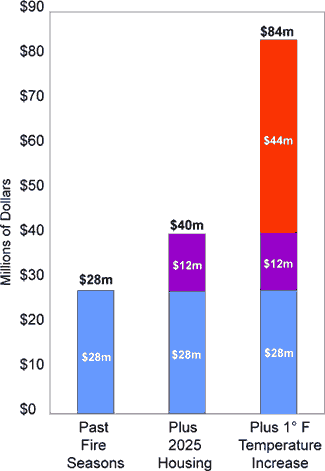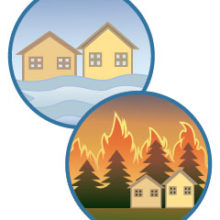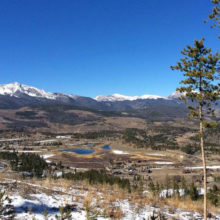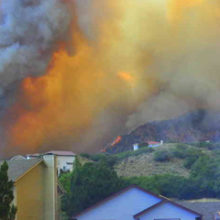This report (4M PDF) examines how residential development adds to the costs of fighting wildfires, using Montana as a case study. Our findings document a strong correlation between the costs of fighting wildfires and the number of homes threatened and the potential for significant increases in the costs of fire protection if current development trends continue.
For example, statewide, the cost of protecting homes from wildfires has averaged $28 million annually. If development near fire-prone forests continues, costs to protect homes likely will rise to $40 million by 2025. A 1º F increase in summer temperatures would at least double home protection costs. Additional development and hotter summers combined could increase the annual cost to exceed $80 million by 2025 (see figure below).
Summary
Average Annual Cost of Protecting Homes from Wildfires in Montana

Montana’s “big sky” appeal, wealth of recreational opportunities, and growing economy have contributed to rapid population growth in the last few decades, particularly in the western portion of the state. Many of the new homes have been built in rural areas, outside existing cities and towns. Living in Montana’s forests, however, is not a risk free nor a low-cost proposition. Most years, federal, state, tribal and county governments spend millions of dollars suppressing the state’s inevitable wildfires to protect Montanan’s homes in the woods.
To better understand the current and future implications for Montana’s taxpayers, Headwaters Economics analyzed daily fire suppression costs across 18 large fires that burned in Montana during 2006 and 2007, systematically distilling out the portion of total fire suppression costs directly associated with housing — that is: the dramatically higher costs required to fight fires in the “Wildland Urban Interface.”
Montana State University collaborated in the statistical analysis, identifying the fire characteristics that were most responsible for daily firefighting costs, including the size of the fire, the nature of the terrain the fire burned through, whether roads and other infrastructure aided or complicated suppression, and the extent of housing threatened by the fire.
MSU helped determine the relative contribution of each characteristic to the total costs. Headwaters Economics then incorporated these main drivers of firefighting cost into a growth model that projects new development expected in Montana by 2025 based on the state’s recent rate of growth and pattern of development. With these tools, it was possible to understand the increases in firefighting costs that Montana will likely see unless development changes significantly from its current pattern. Key findings of our research include:
- Firefighting costs are highly correlated with the number of homes threatened by a fire.
- The pattern of development (dense vs. spread out) is an important contributing factor.
- When large forest fires burn near homes, costs related to housing usually exceed $1 million per fire.
- As few as 150 additional homes threatened by fire can result in a $13 million increase in suppression costs in a single year.
- For all agencies involved in fire suppression in Montana, the estimated annual costs related to home protection for 2006 and 2007 were approximately $55 million and $36 million, respectively.
- If current development trends continue, fires seasons similar to 2006 and 2007 could cost $15 to $23 million more by 2025, bringing total fire suppression costs associated with homes to between $51 and $79 million dollars. Adjusted for inflation, future costs could be as high as $124 million in 2025.
- A conservative estimate is that 25% of all costs of protecting homes from wildfires within Montana are paid for by the state. Therefore, Montana’s costs for home protection in 2006 and 2007 are estimated to have been $13.9 million and $9.2 million, respectively. By 2025, Montana’s future costs, adjusted for inflation, could be as high as $31 million.
Decisions about how and where to fight fires, and where homes will be built in the future will have a major effect on the state’s firefighting costs. Our research reported here was funded by the Montana State Legislature Fire Suppression Interim Committee.
For more information, see our “Wildland-Urban Interface Trends, Future and Solutions” presentation (PDF) and our “Summary: Wildfire Costs, New Development, and Rising Temperatures” research.
Already a major budgetary concern in the U.S., the cost of fighting wildfires will increase if climate change and development trends continue. Using current cost data for Montana, this study projects that the cost of protecting homes from wildfires will double to quadruple by 2025 if current trends and policies continue.
—Headwaters Economics, “Homes in Wildfire-Prone Areas: An Empirical Analysis of Wildfire Suppression Costs and Climate Change” (PDF)
Unless we address one of the root causes of the problem—home building in wildfire prone areas—the costs of fighting forest fires will continue to escalate.
—Ray Rasker, Headwaters Economics, “Now’s the Time to Tackle Forest Fire Fighting Costs” by
NewWest.Net Writers on the Range essay, 2009-04-09
Full Report: Montana Wildfire Cost Study- Technical Report (4M PDF)



